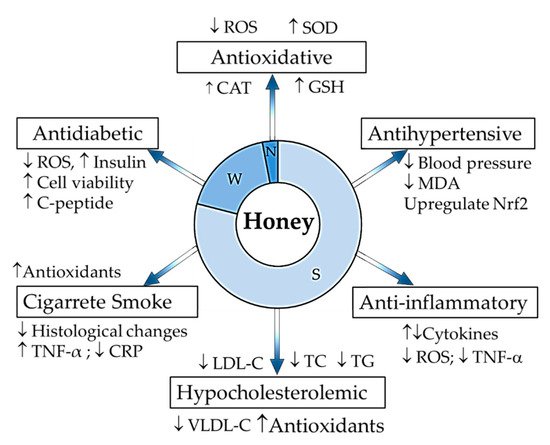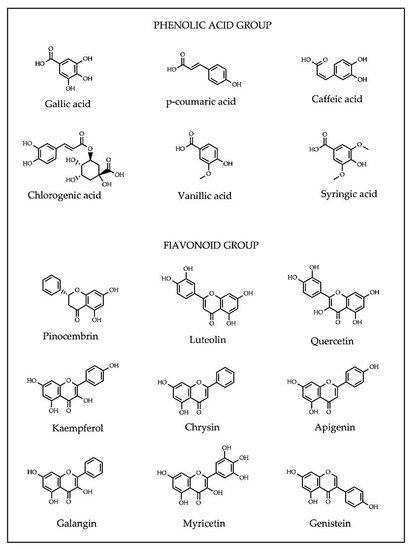Honey, a natural sweetener has been used universally as a complete food and in complementary medicine since early antiquity. Honey contains over 180 substances, including sugars mainly fructose and glucose, water and a plethora of minor constituents such as vitamins, minerals and phytochemicals. Atherosclerosis is a chronic disease occurring in the inner lining of arterial walls due to the progressive plaque formation. Multiple risk factors are implicated in the pathogenesis of atherosclerosis, including oxidative stress, inflammatory responses, hypercholesterolemia, hypertension, diabetes and cigarette smoking
- Honey
- composition
- antioxidants
- atherosclerosis
- inflammation
- oxidative stress
- cholesterol
1. Introduction

2. Honey Composition and Antioxidant Activity
2.1. Honey Composition
|
Proximates (g) |
Minerals (mg) |
Vitamins (mg) |
|||
|---|---|---|---|---|---|
|
Fructose |
38.2 |
Calcium |
3–31 |
Ascorbic acid |
2.2–2.5 |
|
Glucose |
31.3 |
Potassium |
40.0–3500.0 |
Thiamin |
0.0–0.01 |
|
Sucrose |
0.7 |
Copper |
0.02–0.60 |
Riboflavin |
0.01–0.02 |
|
Other disaccharides |
5.0 |
Iron |
0.03–4.00 |
Niacin |
0.1–0.2 |
|
Water |
17.1 |
Magnesium |
0.7–13.0 |
Pantothenic acid |
0.02–0.11 |
|
Organic acids |
0.5 |
Manganese |
0.02–2.0 |
Pyridoxine (B6) |
0.01–0.32 |
|
Proteins, amino acids |
0.3 |
Phosphorus |
2.0–15.0 |
||
|
Sodium |
1.6–17.0 |
||||
|
Zinc |
0.05–2.00 |
||||
|
Se |
0.001–0.003 |
||||

2.2. Key Compositional Standards
|
Criteria |
Values |
|---|---|
|
Moisture content (%) |
≤20.0 |
|
Fructose and glucose (Sum, g/100 g) |
≥60 |
|
Sucrose (g/100 g) |
≤5.0 |
|
Water-insoluble content (g/100 g) |
<0.1 |
|
Electrical conductivity (mS/cm) |
≤0.8 |
|
Free acid (meq/kg) |
≤50.0 |
|
Diastase activity (Schade scale) |
≥8.0 |
|
Hydroxymethylfurfural (HMF, mg/kg) |
≤40.0 |
2.3. Antioxidant Capacity
3. Honey in Relieving Multiple Facets of Atherosclerosis
3.1. Oxidative Damage
|
Honey Type |
Research Model |
Main Findings on Honey Effects |
Reference(s) |
|---|---|---|---|
|
Local honey |
Rat kidney, brain, liver and lung homogenates |
↓ Lipid hydroperoxides and malondialdehyde (MDA) value |
[81] |
|
Christmas vine, Morning glory, black mangrove, linen vine singing bean honey |
Rat liver homogenates |
Highest radical scavenging capacity in linen vine honey ↓ Lipid peroxidation |
[82] |
|
Fireweed, tupelo, Hawaiian Christmas berry clover, acacia, buckwheat, soybean honey |
Human blood serum |
AOC is different among honeys, ↓ Lipoprotein oxidation (LPO) Correlation of ORAC value and LPO inhibition. |
[64] |
|
Acacia, coriander, sider and palm honey |
Human LDL |
High antioxidant activity in xanthine-xanthine oxidase system and LDL oxidation |
[79] |
|
Buckwheat honey |
Human blood serum |
↑ Serum antioxidant capacity |
[80] |
|
Multifloral honey |
Human red blood cells (RBC) |
↓ Lipid peroxidation |
[83] |
|
Multifloral honey |
RBC |
↓ Extracellular ferricyanide level |
[84] |
|
Christmas vine, linen vine honey |
RBC |
Protection of human erythrocyte membranes from oxidative damage ↑ Defence responses and ↑ cell functions |
|
|
Native multifloral honey |
Endothelial cell (EA.hy926) |
Protection of EA.hy926 from hydrogen peroxide and peroxyl radical Synergistic effect of phenolic antioxidants in honey |
[87] |
|
Gelam honey |
Rat blood sample |
↑ Antioxidant enzyme activities |
[88] |
|
Multifloral honey |
Rat plasma and heart tissue |
↓ Hypertriglyceridemia and pro-oxidative effects ↑ Plasma α-tocopherol and α-tocopherol/triglycerides, ↓ plasma NOx, ↓ peroxidation |
[89] |
|
Buckwheat honey |
Human blood plasma |
↑ Plasma antioxidant activity, ↑ defences against oxidative stress |
[90] |
AOC: antioxidant capacity, ORAC: oxygen radical absorbance capacity, LPO: lipoprotein oxidation, LDL: low density lipoprotein, RBC: Human red blood cells, TG: triglycerides, NOx: nitrogen oxides.
3.2. Inflammatory Responses
3.3. Hypercholesterolemia
|
Honey Type |
Research Model |
Main Findings of Honey Effect |
Reference(s) |
|---|---|---|---|
|
Honeydew honey |
Rat blood serum |
Similar weight gain and body fat in honey and control group; ↓ HbA1c, ↑ HDL-C |
[107] |
|
Clover honey |
Rat blood serum |
↓ Weight gain and adiposity, ↓ TGs but ↑ non-HDL-C levels |
[108] |
|
Native honey |
Rat blood samples |
↓ glucose and lipids no deteriorated effects on hyperglycaemia and dyslipidaemia |
[109] |
|
Local honey |
Rat blood serum |
↑ Plasma TG, HDL-C and VLDL-C but ↓ plasma LDL-C and TC |
[110] |
|
Tualang honey |
Rat heart tissue |
↑ Antioxidant enzyme levels in heart tissue and ↓ lipoprotein oxidation (LPO) |
[111] |
|
Tualang honey |
Rat blood serum, kidneys |
↓ TC and TG compared to the control at 7 days; ↓ Serum creatinine level than no honey group after 48 h; No structural effect histologically in the HCD-fed rats |
[112] |
|
Gelam, Acacia honey |
Rat blood serum, internal organs |
↓ Excess weight gain and adiposity index; ↓ plasma glucose, TGs, TG and obesity at similar levels to orlistat drug group |
[113] |
|
Malícia honey |
Rat blood serum, liver |
↓ Food consumption, ↑ glucose tolerance and SOD activity; ↓ TC, LDL and AST levels; ↑ beneficial bacteria and organic acids; Colon and liver was protected |
[114] |
|
Natural local honey |
Healthy, diabetic and hyperlipidaemic human subjects, blood samples |
↓ Blood lipids, homocysteine and C-reactive protein (CRP) in normal and hyperlipidaemic subjects; ↓ plasma glucose elevation in diabetics |
[115] |
|
Natural honey |
Human plasma |
↓ TC (3.3%), LDL-C (4.3%), TGs (19%) and CRP (3.3%) in elevated variable subjects; No increased body weight in overweight or obese participants |
[116] |
|
Natural unprocessed honey |
Type 2 diabetes human subjects, weight and blood samples |
↓ Body weight, TC, LDL-C, TGs ↑ HDL-C and HbA1C levels |
[32] |
|
Kanuka honey, formulated with cinnamon, chromium and magnesium |
Type 2 diabetes human subject, weight and blood samples |
↓ Weight Improve blood lipid profile |
[117] |
HbA1c: Haemoglobin A1c, HDL-C: high density lipoprotein cholesterol, LDL-C: low density lipoprotein cholesterol, VLDL-C: very low density lipoprotein cholesterol, TC: total cholesterol, TGs: triglycerides, LPO: lipoprotein oxidation, HCD: high cholesterol diet, AST: aspartate aminotransferase, CRP: C-reactive protein.
3.4. Hypertension
3.5. Diabetes
3.6. Cigarette Smoking
4. Adverse Effects of Honey
This entry is adapted from the peer-reviewed paper 10.3390/nu11010167
